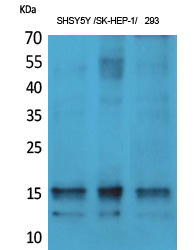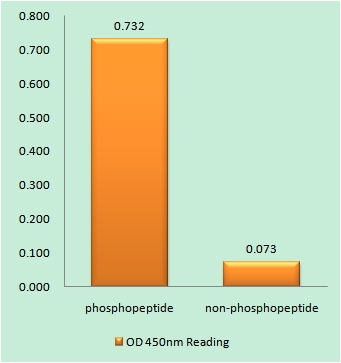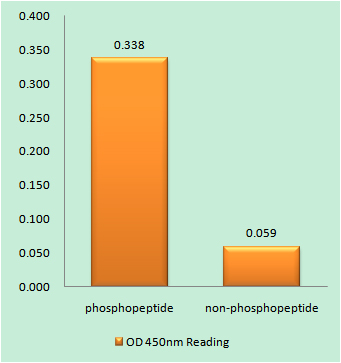
Catalog: KA1340C
Size
Price
Status
Qty.
96well
$470.00
In stock
0
Add to cart


Collected


Collect
Main Information
Reactivity
Human, Mouse, Rat
Applications
ELISA
Conjugate/Modification
Phospho
Detailed Information
Storage
2-8°C/6 months,Ship by ice bag
Modification
Phospho
Detection Method
Colorimetric
Related Products
Antigen&Target Information
Gene Name:
SNCA
show all
Other Name:
SNCA ;
NACP ;
PARK1 ;
Alpha-synuclein ;
Non-A beta component of AD amyloid ;
Non-A4 component of amyloid precursor ;
NACP
NACP ;
PARK1 ;
Alpha-synuclein ;
Non-A beta component of AD amyloid ;
Non-A4 component of amyloid precursor ;
NACP
show all
Database Link:
Background:
alternative products:Additional isoforms seem to exist,disease:Brain iron accumulation type 1 (NBIA1, also called Hallervorden-Spatz syndrome), a rare neuroaxonal dystrophy, is histologically characterized by axonal spheroids, iron deposition, Lewy body (LB)-like intraneuronal inclusions, glial inclusions and neurofibrillary tangles. SNCA is found in LB-like inclusions, glial inclusions and spheroids.,disease:Defects in SNCA are a cause of autosomal dominant Parkinson disease 1 (PARK1) [MIM:168601, 168600]. Parkinson disease (PD) is a complex, multifactorial disorder that typically manifests after the age of 50 years, although early-onset cases (before 50 years) are known. PD generally arises as a sporadic condition but is occasionally inherited as a simple mendelian trait. Although sporadic and familial PD are very similar, inherited forms of the disease usually begin at earlier ages and are associated with atypical clinical features. PD is characterized by bradykinesia, resting tremor, muscular rigidity and postural instability, as well as by a clinically significant response to treatment with levodopa. The pathology involves the loss of dopaminergic neurons in the substantia nigra and the presence of Lewy bodies (intraneuronal accumulations of aggregated proteins), in surviving neurons in various areas of the brain.,disease:Defects in SNCA are the cause of Lewy body dementia (DLB) [MIM:127750]. DLB is a neurodegenerative disorder clinically characterized by dementia and parkinsonism, often with fluctuating cognitive function, visual hallucinations, falls, syncopal episodes, and sensitivity to neuroleptic medication. Presence of Lewy bodies are the only essential pathologic features.,disease:Defects in SNCA are the cause of Parkinson disease 4 (PARK4) [MIM:605543, 168600].,disease:Deposition of fibrillar amyloid proteins intraneuronally as neurofibrillary tangles is characteristic of Alzheimer disease (AD). SNCA is a minor protein found within these deposits, but a major non amyloid component.,domain:The NAC domain is involved in the fibril formation. The middle region forms the core of the filaments. The C-terminus may regulate aggregation and determine the diameter of the filaments.,function:May be involved in the regulation of dopamine release and transport. Soluble protein, normally localized primarily at the presynaptic region of axons, which can form filamentous aggregates that are the major non amyloid component of intracellular inclusions in several neurodegenerative diseases (synucleinopathies). Induces fibrillization of microtubule-associated protein tau. Reduces neuronal responsiveness to various apoptotic stimuli, leading to a decreased caspase-3 activation.,PTM:Hallmark lesions of neurodegenerative synucleinopathies contain alpha-synuclein that is modified by nitration of tyrosine residues and possibly by dityrosine cross-linking to generated stable oligomers.,PTM:Phosphorylated, predominantly on serine residues. Phosphorylation by CK1 appears to occur on residues distinct from the residue phosphorylated by other kinases. Phosphorylation of Ser-129 is selective and extensive in synucleinopathy lesions. In vitro, phosphorylation at Ser-129 promoted insoluble fibril formation. Phosphorylated on Tyr-125 by a PTK2B-dependent pathway upon osmotic stress.,PTM:Ubiquitinated. The predominant conjugate is the diubiquitinated form.,similarity:Belongs to the synuclein family.,subcellular location:Membrane-bound in dopaminergic neurons. Also found in the nucleus.,subunit:Soluble monomer which can form filamentous aggregates. Interacts with UCHL1 (By similarity). Interacts with phospholipase D and histones.,tissue specificity:Expressed principally in brain but is also expressed in low concentrations in all tissues examined except in liver. Concentrated in presynaptic nerve terminals.,
show all
Function:
microglial cell activation, cell activation, regulation of receptor recycling, positive regulation of receptor recycling,positive regulation of neurotransmitter secretion, synaptic transmission, dopaminergic, response to molecule of bacterial origin, myeloid leukocyte activation, regulation of leukocyte activation, generation of precursor metabolites and energy, oxidative phosphorylation, cellular amino acid derivative metabolic process, biogenic amine metabolic process, catecholamine metabolic process, fatty acid metabolic process, neutral lipid metabolic process, phospholipid metabolic process, phosphorus metabolic process, phosphate metabolic process, cellular ion homeostasis,endocytosis, receptor-mediated endocytosis, anti-apoptosis, defense response, immune response, response to oxidative stress, mitochondrion organization, mitochondrial membrane organization, cell-cell signaling, synaptic transmission, nerve-nerve synaptic transmission, behavior, locomotory behavior, adult locomotory behavior, amine biosynthetic process, response to bacterium, catechol metabolic process, response to organic substance, response to inorganic substance, response to metal ion, response to iron ion, response to iron(II) ion, membrane invagination,negative regulation of peptidase activity, regulation of cellular ketone metabolic process, positive regulation of macromolecule metabolic process, negative regulation of macromolecule metabolic process, negative regulation of organelle organization, positive regulation of cell communication, regulation of cell death, regulation of glutamate secretion, regulation of dopamine secretion, energy derivation by oxidation of organic compounds, membrane organization, vesicle-mediated transport, phosphorylation, phenol metabolic process, regulation of lipid metabolic process, regulation of fatty acid metabolic process, transmission of nerve impulse, organophosphate metabolic process, cellular homeostasis, electron transport chain, respiratory electron transport chain, regulation of endocytosis,adult behavior, regulation of histone modification, negative regulation of histone modification, regulation of protein modification process, negative regulation of protein modification process, receptor internalization, regulation of neurological system process, positive regulation of neurological system process, response to magnesium ion,regulation of cellular protein metabolic process, negative regulation of cellular protein metabolic process, regulation of transporter activity, negative regulation of transporter activity, response to lipopolysaccharide, regulation of monooxygenase activity, negative regulation of monooxygenase activity, regulation of organelle organization,regulation of chromosome organization, cellular response to stress, response to cytokine stimulus, diol metabolic process, response to interferon-gamma, cellular response to oxidative stress, regulation of histone acetylation,negative regulation of histone acetylation, regulation of locomotion, macrophage activation, regulation of membrane potential, cellular amino acid derivative biosynthetic process, biogenic amine biosynthetic process, dopamine biosynthetic process, dopamine metabolic process, catecholamine biosynthetic process, response to drug,homeostatic process, ATP synthesis coupled electron transport, mitochondrial ATP synthesis coupled electron transport, regulation of apoptosis, regulation of macrophage activation, negative regulation of apoptosis, regulation of programmed cell death, negative regulation of programmed cell death, negative regulation of catalytic activity,receptor metabolic process, negative regulation of caspase activity, regulation of caspase activity, regulation of neuron apoptosis, negative regulation of neuron apoptosis, regulation of system process, negative regulation of molecular function, nitrogen compound biosynthetic process, innate immune response, leukocyte activation, cellular respiration, positive regulation of endocytosis, regulation of neurotransmitter secretion, regulation of synaptic plasticity, regulation of neuronal synaptic plasticity, regulation of long-term neuronal synaptic plasticity, synaptic vesicle endocytosis, synaptic vesicle transport, chemical homeostasis, regulation of catecholamine secretion, ion homeostasis, regulation of synaptic transmission, positive regulation of synaptic transmission, regulation of acyl-CoA biosynthetic process, regulation of cell activation, neurological system process, regulation of secretion, positive regulation of secretion, positive regulation of transport, negative regulation of transport, negative regulation of cellular component organization, positive regulation of cellular component organization, regulation of cofactor metabolic process, regulation of coenzyme metabolic process, positive regulation of multicellular organismal process,negative regulation of protein metabolic process, regulation of hydrolase activity, regulation of oxidoreductase activity,negative regulation of hydrolase activity, negative regulation of oxidoreductase activity, regulation of neurotransmitter uptake, negative regulation of neurotransmitter uptake, regulation of neurotransmitter transport, negative regulation of neurotransmitter transport, positive regulation of neurotransmitter transport, regulation of serotonin uptake,negative regulation of serotonin uptake, membrane depolarization, regulation of amine transport, negative regulation of amine transport, regulation of transmission of nerve impulse, positive regulation of transmission of nerve impulse,regulation of peptidase activity, regulation of endopeptidase activity, cellular chemical homeostasis, oxidation reduction, regulation of postsynaptic membrane potential, regulation of excitatory postsynaptic membrane potential,long-term synaptic potentiation, regulation of cellular localization, negative regulation of cell death, regulation of vesicle-mediated transport, response to interleukin-1,
show all
Cellular Localization:
Cytoplasm . Membrane . Nucleus . Cell junction, synapse . Secreted . Cell projection, axon . Membrane-bound in dopaminergic neurons (PubMed:15282274). Expressed and colocalized with SEPTIN4 in dopaminergic axon terminals, especially at the varicosities (By similarity). .
show all
Tissue Expression:
Signaling Pathway
Reference Citation({{totalcount}})
Catalog: KA1340C
Size
Price
Status
Qty.
96well
$470.00
In stock
0
Add to cart


Collected


Collect
Recently Viewed Products
Clear allPRODUCTS
CUSTOMIZED
ABOUT US
Toggle night Mode
{{pinfoXq.title || ''}}
Catalog: {{pinfoXq.catalog || ''}}
Filter:
All
{{item.name}}
{{pinfo.title}}
-{{pinfo.catalog}}
Main Information
Target
{{pinfo.target}}
Reactivity
{{pinfo.react}}
Applications
{{pinfo.applicat}}
Conjugate/Modification
{{pinfo.coupling}}/{{pinfo.modific}}
MW (kDa)
{{pinfo.mwcalc}}
Host Species
{{pinfo.hostspec}}
Isotype
{{pinfo.isotype}}
Product {{index}}/{{pcount}}
Prev
Next
{{pvTitle}}
Scroll wheel zooms the picture
{{pvDescr}}



















